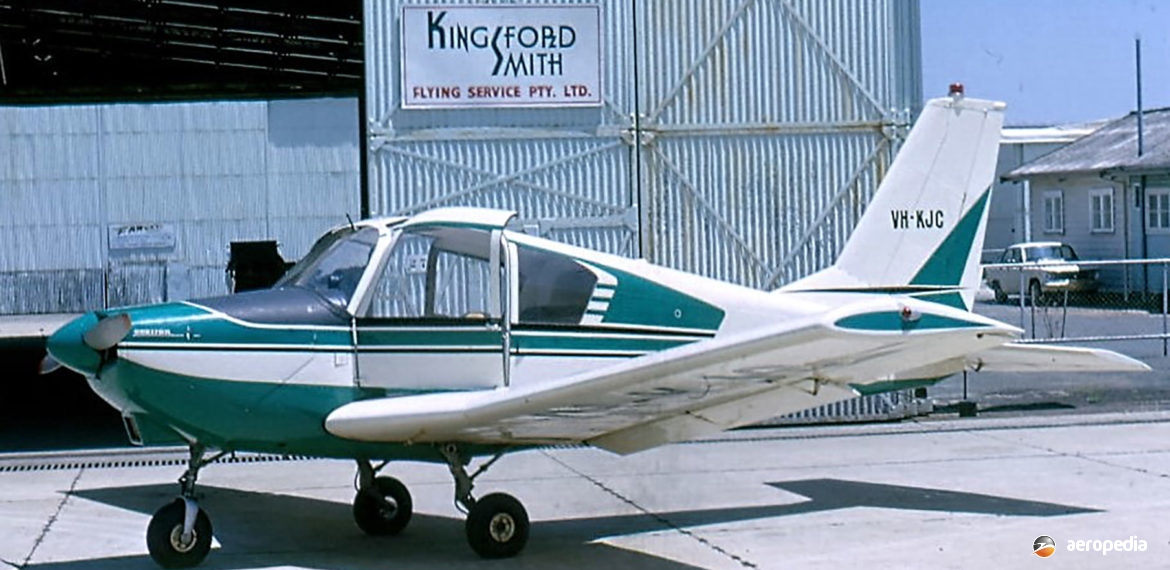Photograph:
Gardan GY-80-160D Horizon VH-KJC (c/n 182) at Bankstown, NSW in November 1967 (David C Eyre)
Country of origin:
France
Description:
Four-seat light cabin monoplane
Power Plant:
One 112 kw (150 hp) Lycoming O-320-A four-cylinder horizontally-opposed air-cooled engine; or
One 119 kw (160 hp) Lycoming O-360-A four-cylinder horizontally-opposed air-cooled engine
Specifications:
- Wingspan: 9.7 m (31 ft 10 in)
- Length: 6.57 m (21 ft 6½ in)
- Height: 2.6 m (8 ft 6 in)
- Wing area: 13 m² (139.9 sq ft)
- Max speed: 260 km/h (162 mph)
- Max cruising speed at 75% power at 2,000 m (6,500 ft): 250 km/h (155 mph)
- Economical cruising speed at 65% power at 2,000 m (6,500 ft): 240 km/h (149 mph)
- Stalling speed: 85 km/h (53 mph)
- Rate of climb at sea level: 280 m/min (920 ft/min)
- Ceiling: 5,800 m (19,000 ft)
- Range with max fuel and no reserve: 1,450 km (900 miles)
- Range with max payload and no reserve: 1,100 km (680 miles)
- Empty weight: 548 kg (1,208 lb)
- Loaded weight: 1,000 kg (2,205 lb)
History:
Yves Gardan, the designer of the Horizon series of light monoplanes, was well known in France as the designer of the CAB Minicab, Supercab, and other aircraft. The prototype of this design, the GY-80, flew on 21 July 1960 powered by a 112 kw (150 hp) Lycoming O-320-A engine.
A cantilever low-wing monoplane, the Horizon’s wing was an all-metal single-spar structure with a rear auxiliary spar. The entire trailing-edge was made up of two Frise slotted ailerons and four Fowler-type flaps of all-metal construction. The flaps were linked to the undercarriage retraction lever and were operated electrically.
The fuselage was an all-metal structure, the forward section being welded steel tube structure, the rear section of light alloy monocoque. The undercarriage was a semi-retractable tricycle-type with oleo-pneumatic shock absorbers. Fuel was located in two tanks in the wing-root leading-edges, with a total capacity of 160 litres (35.2 Imp gals). A pilot and three passengers could be accommodated in an enclosed cabin, with access via a door on each side. Space was available for 36 kg (80 lb) of baggage behind the rear seat. Late in the aircraft’s production life a 134 kw (180 hp) Lycoming engine was offered as an option.
A small number of Horizons have been registered in Australasia, and have included: VH-EOL (c/n 220 – ex F-OCLA), a GY-80-160D, which was first registered in September 1968. This aircraft was flown to Australia from France in March 1968 and was operated by Southern Aeronautics Pty Ltd of Perth, WA. It had a number of owners up until it was retired in 1986 and later underwent some restoration.
VH-KJC (c/n 182), a GY-80-160D, was first registered in May 1967 and was shipped to Australia, being assembled at Bankstown, NSW. It had a number of owners until it was struck off the register in 1984. It was restored in 1988 and has been airworthy, based at Caboolture, QLD.
VH-CJZ (c/n 215 – ex F-OCLI) was a GY-80-180 registered in February 1970. It was flown from Paris in France to Perth, WA in March 1968 by Dr Harold Dicks and was subsequently operated by Southern Aeronautics Pty Ltd of Perth. After a couple of further owners it was retired and after some time at a technical college it was placed on display at the RAAF Aviation Heritage Museum at Bull Creek in Perth.
Three examples have also been registered in New Zealand. ZK-BXM (c/n 128), a GY-80-180, was first registered in March 1965 but was destroyed in a crash at Montalto in January 1999.
ZK-CLK (c/n 71), a GY-80-160, was first registered in April 1965 but in November 1999 was exported to Australia, where it became VH-YOG in January 2000 and since then has been based in Western Australia.
ZK-CFT (c/n 28), a GY-80-150, was first registered in November 1963 and survives in New Zealand.

